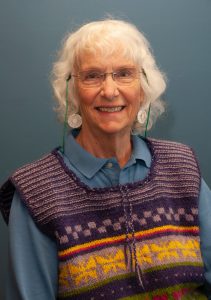 This month’s Tide Bite has a different flavor, written by a student of the arts who spent spring quarter at FHL and has more of a poetic bent than most of our authors. The Spring Marine Studies program allows students to explore different marine science courses that interest them, including the always-popular Marine Mammals of the Salish Sea as well as classes on restoration ecology, invasive species, and one that prompts marine biology majors to reflect on their education and create “portfolios” that prepare them to launch into their next chapter. Our undergraduate curriculum continues to evolve with the times!
This month’s Tide Bite has a different flavor, written by a student of the arts who spent spring quarter at FHL and has more of a poetic bent than most of our authors. The Spring Marine Studies program allows students to explore different marine science courses that interest them, including the always-popular Marine Mammals of the Salish Sea as well as classes on restoration ecology, invasive species, and one that prompts marine biology majors to reflect on their education and create “portfolios” that prepare them to launch into their next chapter. Our undergraduate curriculum continues to evolve with the times!
Best,
Dr. Megan Dethier, FHL Director
Make your gift today
The Memory of Water – Spring Marine Studies at FHL
by Nicholas Tolkien
The Spring Marine Studies (SMS) program at UW Friday Harbor Labs in Spring 2025 had 14 students for 10 remarkable weeks. Some were supported by UW’s Mary Gates Foundation, which provides funding to meritorious UW students in a course that involves research. Other essential funding came from FHL donor funds, including the Adopt-a-Student Fund.
Nicholas Tolkien is an MFA candidate in Creative Writing at Queens University of Charlotte. He is an alumnus of the Tin House Winter Workshop, the New York State Summer Writers Institute, and the Iowa Writers’ Workshop Summer Program. A recipient of the Morton Marcus Poetry Prize, he is currently at work on a book about the endangered Southern Resident killer whales.
I trampled through the forests of Friday Harbor Labs, trying to avoid stinging nettles and garter snakes in a landscape shaped by glaciers fourteen thousand years ago, only to find myself with a choice; either I could climb up the rocks I had slid down, or walk back through the sea. If I climbed, I would be navigating a dense forest past Menzies’ larkspur and Nuttall’s knotweed or if I descended, I would take my chances wading. How had I ended up here? I was told by other students there were killer whales in the channel.
Beneath the waters that Melville once wrote of in Moby Dick — “Consider them both, the sea and the land; and do you not find a strange analogy to something in yourself?” — there is an ecosystem that is rapidly changing. Consider the sunflower star, five billion of which died of sea star wasting disease after the marine heatwave of 2014, or depletion of the killer whale’s critical food source, Chinook salmon, from the warming waters.
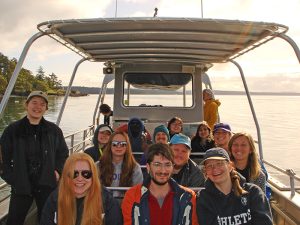
It was killer whales that led me to the Spring Marine Science program at FHL and our marine mammal teacher Dr. Giles, who brings world class experts to class: researchers like Jessica Farrer who studied Weddell Seals in Antarctica or Dr. Marla Holt from NOAA who studies killer whale acoustics.
The SMS program at FHL was divided into five courses: Marine Mammals of the Salish Sea, Novel Marine Ecosystems, Novel Restoration Ecology, Portfolio and Seminar. Each day is different. We could be working in a sunflower star lab, going on boats to look for marine mammals or studying crabs in the intertidal.
In the distance, a ferry shot a black column of soot into the blue sky, and recreational whale watching boats prowled the channel like surveillance agents. Now, a gray whale had also been spotted. I sat down and scanned the horizon, seeing my friends who had taken the shore trail and not become lost as I did, jumping up and down in excitement, looking through binoculars. From my corner where the land jutted in, I could not see anything.
Maybe it was for the best. I hoped the orcas were not Southern Residents, that those had given the whale watching boats the slip and crossed into Canada.
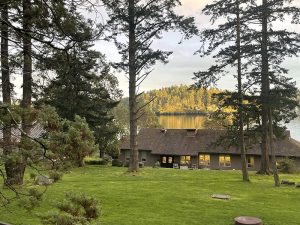
My mom used to study oceanography in school, before becoming a writer. Now I am following in her footsteps, researching a book I’m writing about the Southern Residents, with a particular focus on what Ken Balcomb called their “slow-motion extinction.” What role is climate change playing in the decline of their preferred prey: the Chinook salmon, affected by rising water temperatures and decreased stream flow?
We know a solution to their march to extinction: to breach the Snake River dams. The Southern Residents congregate at the mouth of the Columbia River, drawn to a series of waterways leading to pristine, cold waters of high elevations. There, wild Chinook salmon still carry the spring-run migration gene causing them to grow toward the hundred-and-twenty-pound giants they once were, when the whales were always eating and didn’t suffer their current high rate of pregnancy failures at 69%.
Dr. Giles remembers summers when the Southern Residents were everywhere, diving together and doing the “West Side shuffle” along the coast of San Juan Island. She wants the whales to return to a time when they could rest whenever they chose, instead of hunting nearly constantly. Now they are even hunting together at night, searching for the large salmon that have all but disappeared – salmon that swim up to Alaska where they are caught and sold as “Alaskan salmon” for the equivalent of seventy dollars per fish in Portugal or Japan.
I try to read the landscape as Indigenous Lummi elder and teacher Tim Ballew Sr. taught us. He spoke of how spending twenty hours a day on a small fishing boat and rising to meet the morning at four o’clock changes how you see the water. How the salmon are part of us, and the orcas are our relatives. Of seeing schools of sockeye leaping around his boat like rain and how his brother witnessed a gray whale giving birth in the waters off Orcas Island. We stood outside the place where the Lummi people’s longhouse used to be before it was burned down by the British: thousands of years of presence turned to ash. Walking through these lands is to walk through places that have been taken. This “assimilation” is a painful process for Tim’s people, one that is still ongoing.
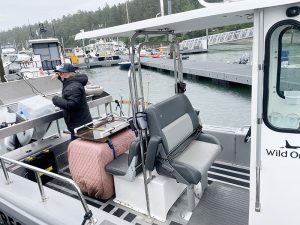
The water here looks beautiful but contains hidden dangers. The Orca Behavior Institute tells me we do not name the killer whale calves until they are a year old because many do not survive, suffering from PCB contamination and hunger. But even if they live just a day, the whales have names to me.
Giles and her trusty whale-scat-detector dog Eba are using novel ways to monitor the health of Southern Resident killer whales using whale scat samples collected from her boat. You can learn a great deal about a whale’s health and their prey from these samples, which are stored in ice and sent to a lab in San Diego for analysis. When I met Eba, I found a beautiful, eleven-year-old rat terrier. Once, she was a lethargic puppy who weighed in at just 3 ½ pounds when she was abandoned at a Sacramento animal shelter, before being adopted by Giles. Giles also named her whale detection boat Cheena, after another beloved dog.
My pug Roxy passed away over a year ago. She was a fighter like Eba. Given three months to live, she lived four years with a rare form of adenocarcinoma. I sense her spirit in the pink Cascadian mountains glittering in the evening light. I was deeply close to her, and I carried this grief with me through my time at FHL.
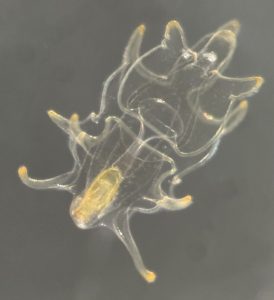
When I pipette larval sunflower stars in lab, I think of how Dr. Jason Hodin says people fail to understand the importance of juvenile things. I think even things I can only see under a microscope — such as an urchin pushing its spines into the body of a sunflower star, seeming to fight it — respond to the same evolutionary processes as a killer whale pushing salmon into a crevice in a rock face. The interaction of creatures tells the greater story, whether they are tiny or gigantic.
If I were to take the safer route out of the forest and navigate my way back through the wooden houses and old buildings of FHL — taking me through a century of history, to when the land was first given to the University of Washington — I would eventually end up in Nearshore Restoration Ecology, my next class that Thursday. Working in Dr. Hodin’s lab all quarter, while also being a poet pursuing my master’s degree, has been a novel experience in seeing how science is done up close. Outside, tanks of sea stars have names like Ophelia and Charlotte. One day we heard Ophelia had curled an arm. Jason, wearing a “Sea Star Wars” T-shirt, showed me a color-coded bar chart of the symptoms his stars exhibit, ranging from green to orange to red. “When the sea star curls an arm,” he told me, “it’s a bad sign,” suggesting sea star wasting disease.
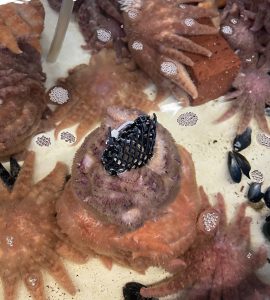
She was given a probiotic and moved into quarantine. She lost two more arms and Jason feared he would eventually find her dead. But over time she recovered from wasting; the first to be successfully treated by Dr. Hodin’s lab. Her mother Charlotte, however, was not doing so well. Sometimes when stars are reunited, they seem to move closer to one another and touch. Do these beautiful creatures sense some kinship with each other, or are we once again anthropomorphizing what we don’t fully understand? What is clear is that the work Jason Hodin is doing in the captive sea star breeding program is crucial for how we keep species from becoming extinct in the climate crisis. If we can save sunflower stars from extinction, restore coral reefs, and create habitats of eelgrass and kelp, we are in a way saving life itself.
Do sea stars feel grief? Do whales? A few years ago, the Southern Resident Tahlequah carried her dead calf’s body for seventeen days. What else could a whale do to express their shared sense of mourning?
Consider Scarlet, the killer whale calf who survived for months against the odds in 2018, even as she became the thinnest killer whale alive. Giles says “I have never seen an animal with such a will to live.” Even when Scarlet was close to death, her mother and siblings tried to keep her swimming. Scarlet was born breech. She bore deep rake marks near her dorsal fin, made when an adult whale used its teeth to pull her from the birth canal, earning her the nickname “Scarlet.” From the beginning, she was smaller than her peers, but what she lacked in size she made up for in spirit. She once famously breached over 60 times in a single afternoon, her small body arching through the air. At four years old, Scarlet was battling a heavy parasite load. By summer, she had lost an estimated twenty percent of her body mass. Despite exhaustion and hunger, Scarlet fought to stay with her family and remained until the end with the same pod that had midwifed her into life.
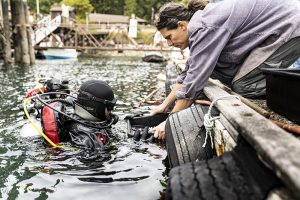
A year after my own beloved dog’s passing, I was in the Whale Museum in Friday Harbor with my class, articulating the skeleton of a gray whale calf that had been struck by a boat. As I carried bones around, I realized the entire process felt like a kind of ritual. We were remaking something: its form, its being; even the tiny pelvic bone had its place. Several hours later, walking through the upper level of the museum, seeing skeletons of other whales encased in glass, tears welled in my eyes. It wasn’t just seeing what was important for understanding, but remaking things.
To learn about whales and to study sea stars in the lab is to learn how we need to remake the habitats that humans have collectively destroyed. Whether through man-made climate change, or the violent historical capture of Southern Resident killer whales using dynamite at sites like Penn Cove — separating calves from their mothers — we are all complicit in the changes that are happening to our planet.
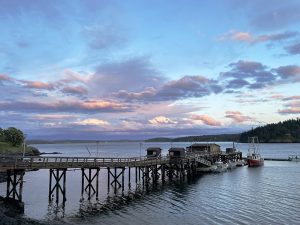
After making it to the top of the hill, I did not see the killer whales traveling south or the gray whale in the center of the channel. It was a beautiful day though; clouds were scattered all the way over Mount Baker, and in the distance, sunlight illuminated Brown Island. A harbor seal poked its large eyes out of the water before returning to the depths. I could see the sea now as a living being — as a “her,” as Elder Tim Ballew Sr. had called her — as a place where the salmon and the old trees were connected, a place where killer whales have developed their own culture and familial bonds. I thought then that I understood part of what the marine mammal program was truly about. It was about learning how to see the water differently, and then — as Melville said — to see some “strange analogy” in myself.
At dusk, I felt the sun setting over the mountains. The water seemed swept up in its light. From the smallest roof of the Whale Museum to a swarm of marbled murrelets in the water, the whole of Friday Harbor felt alive. I thought of how we are all, in a way, both vanishingly small yet significant; how we are all, in our own way, learning how to navigate difficult terrain. Far off, I noticed dark fins rising from the water — the killer whales were surfacing, blowing air out into the darkening sky. I could even hear them now, surfacing to breathe. Light raindrops began to fall. As the magic-hour light faded into dusk, all that remained was the sound of water moving out of the blowholes of the whales. I thought of my own grief — how lonely and silent it is — but it is okay to think deeply about all we have lost and are losing, even if the way we respond is filled with mystery and wonder.
Tide Bites is a monthly email with the latest news and stories about Friday Harbor Labs. Want more? Subscribe to Tide Bites or browse the archives.